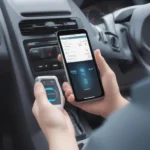Understanding how to use your Autel OBD2 scanner can unlock a wealth of information about your vehicle’s health and performance. Whether you’re a seasoned mechanic or a car enthusiast, this guide provides step-by-step instructions on how to use an Autel OBD2 scanner effectively.
Getting Started with Your Autel OBD2 Scanner
Before diving into the instructions, let’s cover some basics. OBD2, which stands for On-Board Diagnostics, is a standardized system that allows external electronics to interface with your car’s computer. An Autel OBD2 scanner acts as this interface, retrieving data from your car’s Engine Control Unit (ECU).
Locating Your Car’s OBD2 Port
The first step is to locate your vehicle’s OBD2 port. This port is typically found under the driver’s side dashboard, near the steering column. However, its location can vary slightly depending on the make and model of your vehicle. If you’re unsure, consult your owner’s manual.
Connecting the Autel Scanner
Once you’ve located the OBD2 port, connect your Autel scanner using the provided cable. The scanner should power on automatically. If not, refer to your Autel user manual for specific instructions.
Navigating the Autel OBD2 Scanner Menu
Autel scanners are known for their user-friendly interfaces. Most models utilize a combination of buttons and a clear LCD screen. Familiarize yourself with the menu layout, which often includes options such as:
- Read Codes: This function retrieves and displays any stored Diagnostic Trouble Codes (DTCs) from your car’s ECU.
- Erase Codes: After addressing the underlying issue, use this option to clear the stored DTCs.
- Live Data: This mode provides real-time data streams from your vehicle’s sensors, such as engine RPM, coolant temperature, and oxygen sensor readings.
- Special Functions: Depending on your Autel model, you might have access to advanced features like ABS bleeding, airbag system resets, and more.
Understanding and Interpreting Diagnostic Trouble Codes
When your Autel scanner reads a DTC, it will typically display a combination of letters and numbers. These codes are standardized and correspond to specific issues within your vehicle’s systems. For example, a code “P0301” signifies a misfire detected in cylinder number 1.
However, it’s important to remember that DTCs are starting points for diagnosis, not definitive answers.
Using Live Data for In-Depth Analysis
The “Live Data” feature on your Autel scanner provides a dynamic view of your engine’s performance. By monitoring parameters like oxygen sensor readings and fuel trim values, you can gain insights into the efficiency of your engine’s combustion process.
Advanced Features of Autel OBD2 Scanners
Many Autel models offer advanced functionalities that go beyond basic code reading. These features can be invaluable for DIY mechanics and enthusiasts:
- ABS Bleeding: This function cycles the ABS system to purge air, a crucial step after working on brake lines.
- Airbag System Resets: After an airbag deployment, an Autel scanner can be used to reset the airbag control module.
- TPMS (Tire Pressure Monitoring System) Service: Some Autel scanners can read and reset TPMS sensor data.
Tips for Effective Autel OBD2 Scanner Use
- Consult Reliable Resources: Always cross-reference DTCs with reputable online databases or repair manuals for accurate interpretations.
- Document Your Findings: Keep a record of the DTCs encountered, the freeze frame data (if available), and any live data observations. This information can be extremely helpful for troubleshooting.
- Update Your Scanner: Autel frequently releases firmware updates that improve functionality and add new features. Ensure your scanner is running the latest software for optimal performance.
Conclusion
Mastering the use of your Autel OBD2 scanner empowers you with the knowledge to diagnose and potentially fix issues with your vehicle. From understanding basic DTCs to utilizing live data and advanced functions, an Autel scanner is an indispensable tool for any car owner.
Frequently Asked Questions
Q1: Can I use an Autel OBD2 scanner on any car?
A: Autel scanners are compatible with most vehicles manufactured after 1996 that comply with the OBD2 standard.
Q2: What should I do if the scanner doesn’t power on?
A: First, ensure the scanner is properly connected to the OBD2 port. If it still doesn’t power on, consult the Autel user manual or contact Autel support for assistance.
Q3: Can I clear DTCs without fixing the underlying issue?
A: While you can erase codes, it’s not recommended to do so without addressing the root cause. Clearing codes without fixing the problem will only be a temporary solution.
Q4: Where can I find detailed information about specific DTCs?
A: Reputable online databases, automotive forums, and repair manuals are excellent resources for interpreting DTCs.
Q5: How often should I update my Autel scanner’s firmware?
A: It’s a good practice to check for firmware updates periodically, ideally every few months. You can find the latest updates on Autel’s official website.
Need further assistance with your Autel OBD2 scanner? Our expert team is ready to help! Contact us via WhatsApp: +1(641)206-8880 or Email: [email protected]. We provide 24/7 customer support to address all your queries.
Explore our website for detailed reviews and comparisons of various Autel OBD2 scanners, including the Autel OBD2 Scanner Cable, the Autel AL619 Autolink Engine ABS SRS Auto OBD2 Scanner, and the Autel AP200M OBD2 Scanner Bluetooth. We also offer insights into Autel OBD2 Wireless Scanner options and the powerful Autel OBD2 Scanner Enhanced Scan Tool MaxiLink ML529.


